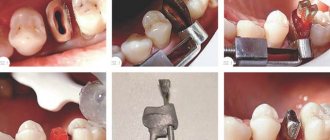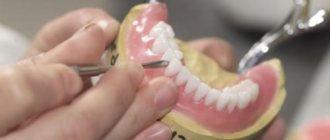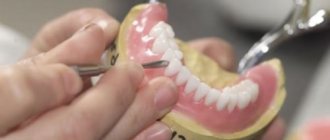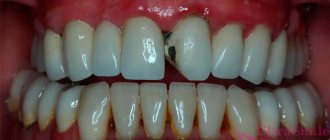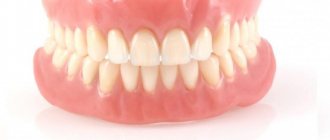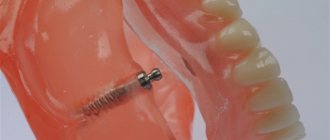Why are all-metal crowns losing their relevance?
Article navigation
- What is the product
- In what cases are such crowns installed?
- Arguments for and against cast structures
- What are the types of cast products?
- What materials are these crowns made from?
- How structures are produced and installed
- Approximate prices
- How to care for cast dentures
- FAQ
Question for a specialist
In Soviet times, crowns made of ordinary metal looked familiar, and gold crowns were considered chic. Today, the idea of aesthetics has changed, dentistry has stepped far forward, and many modern clinics have completely abandoned this type of prosthetics. However, solid metal crowns are still installed in a number of cases - mainly as a budget option for dentition restoration.
Read about what these structures are made of, as well as their improved types, in today’s article.
Advantages and disadvantages of installing solid crowns
The main advantages of installing solid crowns include:
- Affordable price. Installing solid crowns is much cheaper than other types of dental crowns;
— High strength and long service life. Thanks to solid casting technology and durable materials from which the crown is made, high strength and wear resistance are ensured. The service life of such a prosthesis can be up to 10 years;
— When installing solid crowns, it is not necessary to do much grinding of the supporting tooth, thereby preserving much more hard dental tissue;
— Installation of solid-cast crowns does not require soldering, since it is possible to manufacture the entire bridge structure at once.
The disadvantages include low aesthetic appearance. Solid crowns have the color of the material from which they are made, and after installing such prostheses, the smile and the overall aesthetic component of the oral cavity may be reduced.
If you want to preserve the beauty and natural appearance of your teeth, it is better to choose another type of crown: - Metal-ceramic crown (with individualization) - All-ceramic crown with a zirconium dioxide frame For more information about the advantages and disadvantages of installing solid crowns and what type of dental crowns is right for you, You can find out by visiting our family dentistry “Orthodontics”
What is the product
Solid dental crowns got their name based on their manufacturing technology - they are produced using a one-stage casting method in a mold. Models made from individual casts have the anatomical shape of the teeth of the future owner. In this way, it is possible to make both a single product and a bridge to replace several teeth - the technology allows you to do without soldering, which significantly saves time.
In what cases are such crowns installed?
Among the indications for installing solid crowns, experts in the field of dentistry and prosthetics identify the following clinical cases:
- the tooth is severely damaged - loss of dental tissue from 70%. In this case, filling does not make sense, since the pin with the light-polymer material simply will not hold,
- there are malocclusions, abnormalities in the location or shape of teeth,
- supports are needed to fix the bridge,
- pathological abrasion of enamel was diagnosed,
- the patient suffers from bruxism.
It should be noted that such structures can also be installed on the front teeth, but in this case the aesthetics of the smile will be seriously affected.
There are situations where solid, non-removable crowns can even harm the patient. Thus, among the contraindications to their installation are increased tooth sensitivity. The fact is that metal is a conductor of heat, so dental tissue will constantly experience temperature effects. As a result, inflammation of the pulp may develop.
Such designs are also not installed in patients who are allergic to metal. This is not a very common occurrence, but it should not be ignored. If a problem is identified, the dentist will suggest other options.
Increased wear of teeth on the opposite jaw is also a contraindication. Metal is much harder than dental tissue, so antagonistic elements will inevitably be subject to abrasion. If such a problem already exists, it will only get worse with the installation of cast products.
Don't know what type of prosthetics to choose?
We will help in the selection, advise where to read more information and compare types of prosthetics.
Consultation with an orthopedic doctor in Moscow clinics is free! Call now or request a call
Working hours: from 9:00 to 21:00 - seven days a week
Solid crowns
Solid crowns are a type of fixed prosthesis made using the solid casting method. The main materials are all kinds of metal alloys - nickel, chromium, titanium. Such crowns are used, as a rule, to replace defects in chewing teeth; they are not placed in the smile area for aesthetic reasons.
Indications
The installation of solid crowns is used when:
- the presence of defects of carious (caries and its complications) and non-carious (for example, wedge-shaped defect) origin;
- congenital anomalies in the development of the shape or incorrect position of the teeth;
- pathological abrasion.
They are also used when it is impossible to close the defect with filling materials, as a supporting element in the construction of bridges and for splinting teeth (as part of the treatment of periodontal diseases).
Kinds
Today there are several types of solid crowns:
- without spraying
- the most budget option, but at the same time the least attractive in terms of aesthetics; - with sputtering
- gold is often used to create a sputtering effect; - with veneering
- a layer of glaze (ceramics) is applied on top of the metal frame, due to which such a crown is practically no different in appearance from natural teeth; - combined
- as part of a bridge prosthesis, which is a combination of metal and metal-ceramic crowns.
The choice of prosthesis is made at a preliminary consultation, taking into account the patient’s indications and preferences.
Manufacturing
Solid crowns are manufactured in several stages:
- tooth preparation - to install artificial crowns, the tooth must be ground to a thickness of about 0.5 mm, with or without the formation of a ledge;
- taking impressions using alginate or silicone mass - dental impressions are sent to a dental laboratory;
- obtaining plaster models, making wax bases;
- determination of central occlusion;
- production of cast metal crown;
- fitting in the patient's oral cavity;
- final processing - if after fitting no changes or modifications are required in the crown, it is sent for final grinding and polishing.
Before installation, the patient’s oral cavity is thoroughly treated with an antiseptic solution. The crown is fixed with cement. The final step is to check the occlusal relationships.
Advantages and disadvantages
The main advantages of solid crowns are the following:
- high strength;
- abrasion resistance;
- manufacturing accuracy (the finished prosthesis most accurately conveys the shape and dimensions of the tooth being restored);
- low cost.
At the same time, such crowns are less aesthetically pleasing compared, for example, with metal-ceramic or ceramic ones. Due to their metallic color, they are visible to the naked eye (they do not match the natural shade), so they are only suitable for restoring chewing teeth. Due to the high thermal conductivity of metal, unpleasant sensations that occur when eating hot food are also possible.
Arguments for and against cast structures
In addition to the objective, today there is also a preconceived opinion about a solid-cast crown: that it is a product that has no advantages other than a low price. Of course this is not true. The main advantage of the design is durability: with proper installation and proper care, it can last more than 15 years. To present in detail the advantages of cast prostheses, let us compare them in a number of indicators with stamped ones (that is, created not individually, but from a template):
- tight fit: stamped structures are made from factory blanks, which are given an approximate shape using mechanical processing. It is impossible to install such a product tightly to the tooth surface - hence the ingress of food particles under the denture, the proliferation of bacteria, and the development of inflammatory processes. Cast products have high anatomical accuracy, so such problems are excluded,
- strength: the stamping is thin, therefore, under the influence of loads and chemical reactions in the oral cavity, it gradually collapses. After some time, a through hole is formed, opening access to infection. The result is the development of secondary caries, followed by pulpitis. The thickness of the solid crown is 0.3-0.5 mm. This is enough to successfully withstand both mechanical and chemical influences,
- safety: bridges from stamped elements are made by soldering. The connections are not very strong and often break - there is a high probability of injury. In addition, the products themselves and the solder have different compositions. This leads to the emergence of galvanic currents, which, in turn, cause irritation of the mucous membrane. Cast structures are made entirely from one alloy and do not require soldering, so such consequences do not occur.
Interesting! Stamped steel dental products are the oldest in their family. They were worn by many generations of Soviet citizens until the high toxicity of the composition, to which cadmium, beryllium, lead and other impurities harmful to health were added, was discovered. Nowadays such structures are made from a safer alloy, but in general stamping is carried out only in the deep provinces. Similar products have not been produced in any country except Russia for about 100 years.
Thanks to these properties of solid-cast crowns, both clasp and bridge systems using them will be more reliable. Surprisingly, cast metal prostheses have a number of advantages over metal-ceramic products that are popular today. The design is simpler, so it can be manufactured faster. In addition, cast metal is not at risk of chipping, as is the case with a ceramic coating. This product is also thinner than metal-ceramic, therefore, it requires less grinding of the teeth - as a result, they remain more viable.
The main disadvantage of metal prostheses is the lack of aesthetics, which today has acquired special importance. Therefore, such structures are placed only on chewing teeth, which are not very visible to others. But as soon as you laugh heartily, the alien metal will become noticeable.
“I’m 60 years old, and now I need to get my teeth done. Previously, I remember, there was no choice, but now there is nothing on offer. At first I wanted to install metal ones from casting - it doesn’t seem to be visible on the molars. Then I thought: I work as a teacher at school, constantly in public, I would still be embarrassed to talk and smile. I chose metal ceramics and I don’t regret it, I feel absolutely free.”
Vera Sergeevna, patient of one of the Moscow dental centers
Complex on 4 OSSTEM implants with delayed loading - from RUB 170,000.
Complex implantation Osstem (South Korea) with delayed loading after 4-6 months.
Guarantee for the doctor’s work - unlimited Call now or order a call
Opening hours: 24 hours a day - seven days a week
There are also more significant disadvantages. This is both a risk of developing allergies and a danger of damaging neighboring teeth, as well as those located on the opposite jaw - due to the high hardness of the metal. Therefore, if you are not too tight on funds, you should still consider more advanced prosthetic options. In particular, you can also choose a solid metal structure, but with ceramic lining (this will be discussed below).
Stages of treatment: how to prepare, install a crown on a tooth
Below we will analyze in detail each of the stages of prosthetics with crowns, and if you want to get advice directly from a specialist, call and make an appointment with the orthopedic doctors of our dental clinic in St. Petersburg - “Unident”. An initial consultation with an orthopedist at our clinic is provided free of charge!
Inspection and diagnostics
The treatment process begins with a visit to the office of an orthopedic dentist.
The specialist will carefully examine the patient’s oral cavity, identify existing problems, and, if necessary, prescribe a number of additional diagnostic measures. Based on the information collected from the clinical case, the orthopedist will draw up a detailed treatment plan and also offer the patient all possible prosthetic options. A well-designed treatment plan necessarily takes into account not only the installation of a dental crown, but also additional procedures:
- Removal of teeth, restoration and treatment of which is impossible for objective reasons;
- Preliminary treatment of diagnosed diseases of teeth and gums;
- Treatment of tooth canals and their filling (carried out when deciding to depulp a tooth before installing a crown);
- Professional oral hygiene. Sanitation of the oral cavity before prosthetics must be carried out to completely remove hard and soft plaque from the surface of the teeth. The event will allow you to most accurately select the crown to match the color of the patient’s natural tooth enamel, and will also have a positive impact on the quality of treatment.
The preparation of a treatment plan is completed by selecting a specific type of dental crown, after which the total cost of prosthetics is calculated and the timing of its implementation is specified.
Preparatory stage
The duration of the preparatory stage depends on what procedures will need to be carried out before prosthetics to ensure a high-quality and durable result. Below we will consider in detail all the possible stages of preparation for dental prosthetics with crowns.
Depulpation
A few years ago, before installing crowns, teeth were depulped without fail.
But modern orthopedists, if the clinical case allows, strive to keep teeth viable and do without removing the nerve. A tooth with preserved pulp is not deprived of adequate nutrition with minerals and nutrients, and does not acquire increased fragility. Crowns installed on living teeth last longer, but unfortunately, it is not always possible to refuse pulp removal. Most often, the front teeth are depulped, but the chewing dental units are kept alive. They have a fairly large area of the natural crown, in them the distance from the enamel to the pulp chamber is much greater, and therefore the risk of nerve bundle burns when installing a crown will be minimal.
The decision on the advisability of preliminary pulp removal is also made based on the number of roots, which may vary for different teeth. If you plan to install a crown on a single-rooted tooth, the depulpation procedure is mandatory. When treating single-rooted teeth, the risk of pulp burn is too high, and thermal damage to the sensitive nerve bundle is fraught with the occurrence of an inflammatory process under the installed crown. To prevent such negative consequences, single-rooted teeth are depulped, the canal cavities are treated with antiseptic agents and filled with gutta-percha.
Treatment of diseases of teeth and gums
If, during a visual examination of the oral cavity, the doctor discovers caries, signs of the development of an inflammatory process - these conditions must be eliminated before installing crowns.
If the tooth is significantly destroyed by caries, the doctor removes the affected tissue and restores the crown part by installing a durable filling. Pulpitis and periodontitis are treated according to a more complex scheme, which includes treatment of dental canals and filling them. A high-quality and durable filling must be placed on the tooth, otherwise it may fall out, and the installed crown will fall out along with it. In case of severe destruction of a dental unit, its coronal part can be restored in different ways:
- Installing a seal on the pin. A pin is a special structure in the form of a rod, which is inserted into the root canal of the tooth and acts as a reliable support for the filling;
- Stump tab. Inlays for dental restoration are made in a dental laboratory and are installed, like a pin in a canal, but are also fixed in the crown of the tooth.
If a tooth is severely damaged, it is recommended to restore it with an inlay, which is considered more reliable and durable than a conventional filling or installation of a filling on a pin.
Preparatory activities are completed with professional oral hygiene. Sanitation is necessary for the complete and high-quality elimination of dental plaque, which is a favorable environment for the proliferation of pathogenic organisms, in addition, the procedure will allow you to accurately select the color of the crown for installation so that it matches as closely as possible the shade of the natural enamel of the patient’s teeth.
Preparation
Preparation or grinding of teeth is a procedure that the doctor performs before taking impressions.
During the preparation, the tooth enamel will be ground down to the thickness of the future crown. During the grinding process, a drill is used: with its help, the tooth is given a certain shape that can provide the most durable fixation to the installed crown. If living, non-pulp teeth are subjected to preparation, the procedure can be very unpleasant and painful for the patient, and therefore local anesthesia is used before it is performed. The thickness of the enamel removal will depend on the type of crown that will be subsequently placed on the prepared tooth. A maximum of natural tissue is removed from the tooth to install ceramic and metal-ceramic crowns; the enamel is ground down to a minimum before prosthetics with cast crowns.
After the tooth has been prepared, a stump remains, from which the doctor will take impressions to produce crowns.
Laboratory stage
An impression is taken from the ground teeth. To obtain a high-quality, anatomically accurate impression of teeth, a specialized highly elastic mass is used to produce a crown. Using impressions, a dental technician in the laboratory will make a plaster model of the patient’s teeth, which will be used to make crowns for further installation. Dental crowns can be made from a variety of materials - alloys of precious and non-precious metals, ceramics, zirconium dioxide, metal ceramics. The type of crowns for installation is selected based on the characteristics of a specific clinical situation, the patient’s preferences, his wishes for the level of aesthetics, as well as financial capabilities.
The timing of its production will depend on the type of raw material from which the crown will be made. The company has been producing crowns made of ceramics and metal-ceramics for a long time. So that the patient does not have to walk with an unsightly stump during the entire period of crown production, a temporary immediate prosthesis is placed on it for this period. Temporary crowns are made of plastic, and their installation allows you to relieve the patient from psychological discomfort, as well as protect prepared and vulnerable teeth from the action of pathogenic microflora and harmful environmental factors.
Fitting and installation of dental crowns
When the dental technician makes the crown frame, the patient will be invited to the clinic for fitting.
During fitting of the frame part of the crown, the tightness of its fit to the surface of the tooth stump is assessed. If the fit is insufficient, food debris and bacteria will get under the installed crown, and all this can lead to the onset of an inflammatory process. If during fitting the crown fits perfectly on the stump, the frame is sent to the laboratory, where it will be covered with ceramic mass. The finished crown is tried on a second time and during the second fitting it will be fixed with temporary cement mortar. A second check is required to assess the quality of contact between the prosthesis and the opposing teeth, and if it goes well, the crown will be installed on the tooth using permanent cement. The process of permanently installing a crown on a tooth takes place according to the scheme described below:
- The inside of the crown is covered with a layer of cementing solution, after which the crown is put on the tooth;
- A tooth with a crown is exposed to light, which accelerates the hardening process of the cement mortar;
- All excess cement mixture is carefully removed, since it is a rather caustic substance and, if it comes into contact with soft tissue, can cause severe burns.
The treatment ends with a detailed consultation from the orthodontist on the care of the prosthesis and oral cavity after prosthetics. Compliance with the specialist’s recommendations guarantees the absence of negative side reactions and complications after crown installation.
What are the types of cast products?
Modern dentistry has significantly expanded the arsenal of metal casting products. Today the patient can choose designs:
- without spraying: they have a regular metal surface, polished to a shine. Aesthetics are reduced to zero,
- with spraying: to give a white color or a “gold” tint, the solid crown is treated with a special composition using vacuum plasma equipment,
- with partial cladding: ceramic or plastic linings are fixed to the front parts of the products. The teeth look natural, while the design will cost less than classic metal-ceramics,
- with full cladding: this option can no longer be called a product made only of metal. These are rather combined metal-ceramic crowns. Such designs are superior to all others in aesthetics and retain strength due to their metal base.
Spraying options are not suitable for everyone: compositions that are applied to the surface can irritate the oral mucosa. Therefore, to achieve aesthetics on a limited budget, it is still better to choose designs with front cladding, although they also have a drawback - cracks and chips often appear on the linings.
Types of solid crowns
| View | Its features |
| Solid crown without spraying | Conventional orthopedic design; as a rule, from an alloy of cobalt and chromium, less often - nickel and chromium, and even less often - from gold or platinum. Its surface is not covered with anything, so it looks like polished metal. Despite a number of advantages, it is impossible to use such a crown to restore frontal teeth due to its inappropriate appearance. |
| One-piece crown with spraying | The structure is made of coated metal, which is applied using the vacuum-plasma method. It can be “golden” and is not suitable for everyone, since it can cause inflammation and allergic reactions. |
| Solid crown with veneer | Restoring a tooth with a one-piece crown with veneer will allow you to achieve a certain aesthetics, since the crown itself has a special plastic or ceramic lining that imitates native tooth enamel. The plate is installed on the side that is visible when talking or smiling, but there is a risk that it will chip over time. A design with plastic will be cheaper, but over time it will change its color, and the lining itself will wear out, so the metal will begin to show through it. |
| Bridge prosthesis | The one-piece denture has supports on the fifth and seventh teeth. In its manufacture, not only metals are used, but also metal-ceramics for prosthetic teeth that fall into the smile line, and solid analogues for other teeth. |
What materials are these crowns made from?
In the production of the structures under consideration, the following types of materials are mainly used:
- chromium-based alloys with the addition of nickel or cobalt: these are the most common materials characterized by increased strength - prostheses made from them are called carbide. They have the most affordable price, suitable for low-income people,
On a note! Today, one crown without coating will cost about 4 thousand rubles, with titanium nitride coating - about 5 thousand rubles. Ceramic cladding will increase the cost of the product to at least 7 thousand rubles. Treatment of identified pathologies, the work of a doctor, as well as the manufacture and installation of a temporary crown are paid separately.
- alloys of precious metals: solid gold dental crowns have a big advantage - they are biocompatible with the human body, and therefore do not cause allergic reactions. In its pure form, gold is not suitable for orthopedic purposes: it is too soft. Its alloys are used with copper, silver, palladium and even platinum. These compositions do not differ in color from pure metal, so this option in our time is only suitable for eccentric people. And the price is not affordable for everyone,
- alloys with titanium: structures lead in strength - it is 9-10 times higher than that of other products. Like gold, titanium is biologically compatible with natural tissues and does not have a harmful effect on the roots and adjacent teeth. However, such materials are extremely capricious, and the manufacturing process is labor-intensive. In addition, alloys have low adhesion to ceramics, so it will be difficult to create an aesthetic veneer.
It is better to entrust the choice of material for a crown to a specialist. The doctor will take into account all the features and nuances of the clinical picture, on the basis of which he can offer the most suitable option.
How structures are produced and installed
The creation and fixation of products is a standard dental procedure. Thus, the following clinical and laboratory stages of manufacturing solid crowns are distinguished:
- preparatory: through examination and examination, the doctor identifies existing diseases. If necessary, the tooth is treated and strengthened. Then it is prepared for a solid crown using a suitable method: using ultrasound or laser, tunnel or air-abrasive technology. After this, impressions are taken,
- modeling of a solid-cast crown: two models are made - a working one (of the dentition where the prosthesis will stand) and an auxiliary one (simulating the opposite row). Then they create a model - for this they use wax and plaster,
- product manufacturing: the process takes place in the laboratory. When the structure has already been cast, the specialist evaluates the quality of its execution and, at the request of the patient, covers it with ceramics. Then a fitting is carried out on a plaster copy of the patient’s tooth. If necessary, the product is adjusted.
Installation of a solid-cast crown is also performed in several stages. First, it is tried on the prepared tooth. If inaccuracies are identified, the design is returned for revision. Sometimes the product is temporarily fixed in the patient's mouth to determine whether there is any discomfort when chewing or an allergy to the alloy. If everything is in order, the prosthesis is secured with medical cement.
Installation of solid crowns
Installation of solid crowns requires several visits to the dentist. The entire installation procedure can be divided into several stages:
— The first stage is to examine and sanitize the patient’s oral cavity. Then, using a special material, the dentist makes an impression, according to which the prosthesis will be made;
— After the solid crown is made, the second stage of installation begins. At this stage, the doctor prepares the oral cavity for installation of a one-piece denture. To ensure that the crown fits tightly and exactly into the right place, the tooth is ground. Then the fitting and assessment of the prosthesis is carried out. If any errors are detected, the crown may be sent for revision;
— Once the prosthesis fits perfectly, it is fixed using special cement.
If the prosthesis was made well, then the patient will not experience any discomfort after installing solid crowns, and all chewing functions will be restored.
Return to list of services
Approximate prices
The cost of prosthetics consists of several factors, including: an x-ray image - 1000 rubles, fixation of a temporary structure until the permanent one is ready - 2000 rubles, the cast crown itself - 6000 rubles. Of course, these are approximate prices that may vary depending on the level of prestige of the clinic and region of residence. Also, the selected type of metal has a direct impact on the formation of the cost of the product - gold structures are considered the most expensive, their price starts from 15-20 thousand rubles.
Only until 15.01 South Korean implant Osstem - from 18,500 rubles.
Hurry up to sign up for a free consultation and lock in promotional prices.
Call now or request a call
Opening hours: 24 hours a day - seven days a week

